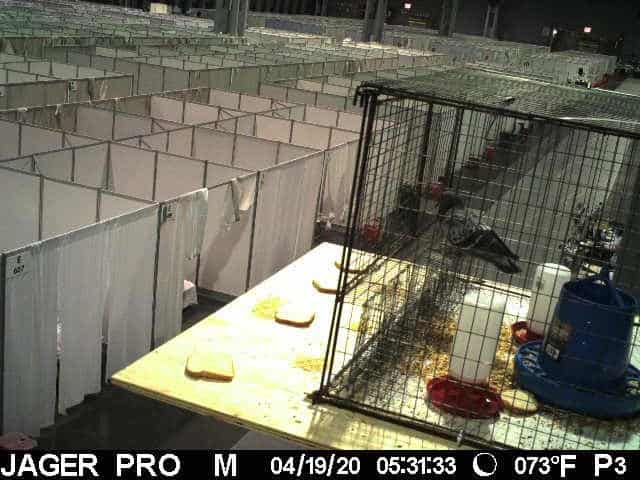Share this article
Ridding a COVID-19 field hospital of pigeon pests — remotely
COVID-19 has affected everyone, and wildlifers are no exception. In this series, TWS is looking at challenges facing the profession due to the pandemic.
When the COVID-19 pandemic threatened to overwhelm hospital capacity in New York City in March, New York Gov. Andrew Cuomo asked the Army Corps of Engineers to construct four field hospitals around the city. At the Javits Center, National Guard members converted the West Manhattan convention hall into a makeshift hospital able to handle 2,500 coronavirus patients.
Within just two days, pigeons infiltrated the building. Since the cavernous convention hall had no ceilings over the areas divided into rooms for patients, the birds could fly overhead and defecate or land and disrupt the patients.
The New York State Office of Emergency Management contacted Wildlife Services to remove the pigeons (Columba livia), but that presented an unusual challenge. How could technicians remove the birds while practicing social distancing to protect themselves from contacting patients?
Wildlife Services and Javits Center staff agreed that Wildlife Services employees themselves couldn’t enter the building. They’d have to figure out a way to remove the pigeons remotely.
“We knew that it would be challenging,” said Allen Gosser, the New York state director of Wildlife Services. “But we also knew that we had to try our best while limiting the risk to our employees.”

A trail camera photo shows a trap set up to remove pigeons from the Javits Center.
Credit: Wildlife Services New York
Wildlife Services worked with the Javits Center’s onsite engineer to provide the conference center’s staff with the necessary resources and assistance to handle the pigeons themselves. Two days after the initial request, a Wildlife Services employee using personal protective equipment met the Javits Center engineer at the loading dock and delivered pigeon removal supplies — bait, bread, traps, watering devices and a cellular trail camera. Wildlife Services also offered recommendations on how to set up the traps around the center. The trail camera was to be mounted near one of the traps. That way, Wildlife Services could remotely monitor the situation and provide additional recommendations.
The center staff — people “who already have a full-time job in what is basically a 24-hour emergency situation” — followed the recommendations diligently, Gosser said. They set the traps, succeeded in capturing some of the pigeons and handed them off to Wildlife Services at the loading dock to be taken away.
They didn’t get them all, though, and with some workers inside feeding the pigeons, it “definitely frustrated our ability to quickly catch the birds,” Gosser said. Also, the traps were baited with bread, but Javits Center staff didn’t realize that the bread should be torn into pieces, Gosser said. Instead, they put out whole slices.
Another challenge was selecting the best trapping locations without Wildlife Services employees on site to use their professional experience. Had they entered the building, they would have conducted a thorough search for hidden entry and exit points and assessed other possible trapping locations. They also would have looked for evidence of people feeding pigeons and put out signs asking people not to do so, Gosser said.
It wasn’t flawless, Gosser said, but “the process was as easy as it could be provided that we did not enter the building. I couldn’t be prouder of how quickly and enthusiastically two of our employees responded to this request.”
The Javits Center hospital released its final patient on May 3 after treating about 1,300 patients.
Wildlife Services is a Strategic Partner of TWS.
Header Image: Pigeons entered the Javits Center after the Manhattan convention center was converted into a COVID-19 field hospital. Credit: New York National Guard








